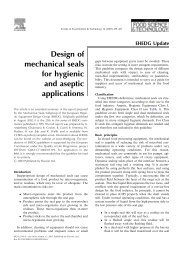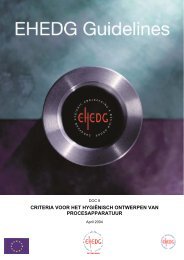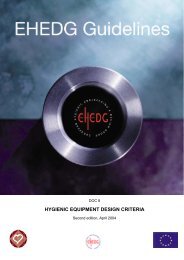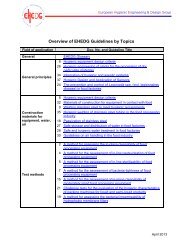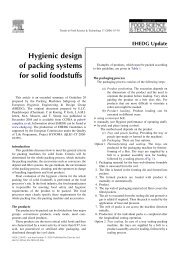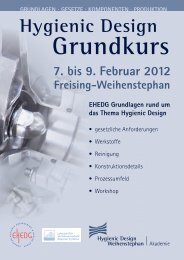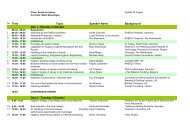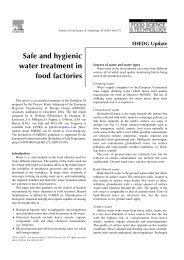Yearbook 2013/2014 - ehedg
Yearbook 2013/2014 - ehedg
Yearbook 2013/2014 - ehedg
Create successful ePaper yourself
Turn your PDF publications into a flip-book with our unique Google optimized e-Paper software.
56 Spray cleaning systems in food processing machines and the simulation of CIP-coverage tests<br />
type as required, into the scene. The computer program is<br />
directly connected with a public nozzle database in which<br />
the specific characteristics of different nozzles are stored<br />
together with the related single spray pattern. Consequently,<br />
the same nozzle doesn’t have to be measured twice at the<br />
same operating parameters. The determination of a single<br />
spray pattern can be managed with an adequate cleaning<br />
test like that described below, or with impact measurements<br />
for example. After insertion, the nozzles can be positioned<br />
and aligned in the scene. The activated nozzle is marked<br />
with a pyramid. This pyramid shows the maximum nozzle<br />
distance in which the nozzle was measured. If the nozzle<br />
is moved outside this range, no cleaning effect is shown on<br />
the surface. The expected cleaning results are calculated<br />
and shown in real-time, so the cleaning system can be<br />
optimised (e.g., insert more nozzles or change their<br />
alignment) in an iterative way without large response time.<br />
After all, the nozzles positions can be exported for using in<br />
CAD software.<br />
Functional principles<br />
Depending on the application area, one could model the<br />
effect of a nozzle as a stream or as a spray of single particles<br />
– omitting particle-particle interaction. In our experiments the<br />
latter approach proved the most feasible. The behaviour of<br />
such an isolated particle could be approximated using the<br />
following formula:<br />
0<br />
Figure 3. Projection principle, from 3D space onto 2D plane with<br />
depth information (as Z). A brighter colour is equivalent to a shorter<br />
distance to the projection plane. Note the intersection of the ray<br />
with the 2D plane.<br />
After identifying where the particles collide with the surface,<br />
the exerted influences<br />
0<br />
on the surface have to be computed.<br />
For this, every nozzle gets a spate of spray masks that are<br />
determined by cleanability tests or impact measurements<br />
(Figure 4).<br />
z<br />
z<br />
where the forces are defined as<br />
•<br />
•<br />
•<br />
•<br />
Numerical algorithms for solving the time integration can be<br />
found in Press et al. (2007) and are efficiently computable<br />
on the GPU (graphics processing unit) as described by<br />
Nguyen (2007). 1,2 But, solving the equation of motion for<br />
millions of particles is just one step. For the interesting<br />
effect of a particle-surface interaction, the intersection of a<br />
particle with a surface has to be found. Despite several<br />
well-known acceleration techniques, a lot of work had to be<br />
done in every time step of the simulation. 3 But experiments<br />
showed that the process could be approximated as linear<br />
with respect to the input parameter domain in focus. These<br />
experiences effectively broke down the simulation to a onetime<br />
step at which the intersection occurs. In the field of<br />
computer graphics this is known as ray-tracing, but instead<br />
of tracing light, the ray’s linear particle paths are traced. 4 A<br />
first implementation produced reasonable results for further<br />
investigations, but it was too slow to be used in interactive<br />
applications. Therefore, the process was modelled as a<br />
projection of surface points in 3D space to 2D points on the<br />
escape plane of the nozzle which is exactly what graphics<br />
processing units (GPUs) are good at doing (Figure 3).<br />
Figure 4. (Left) 2D impact map. Red means high impact. (Right) 2D<br />
spray pattern. A black colour means a point got cleaned during the<br />
spray process.<br />
Thus, deciding whether a point is cleaned through the spray<br />
process becomes essentially the inversion of the projection<br />
mentioned before. This is equivalent to the functional<br />
principle of a slide or movie projector. Here the nozzle is the<br />
projector, the film or slide to be projected is the impact or<br />
spray pattern and the to-be-cleaned surface is the functional<br />
equivalent of the projection screen (Figure 5). In computer<br />
graphics this technique is known as projective texture<br />
mapping or perspective shadow mapping. 5-9<br />
(a)<br />
(a)



